This article relies largely or entirely on a single source .(December 2013) |

The Arlequin is a cinema in Paris, noted for its spacious modernist main theatre and its former role as a showcase of Soviet film.
This article relies largely or entirely on a single source .(December 2013) |

The Arlequin is a cinema in Paris, noted for its spacious modernist main theatre and its former role as a showcase of Soviet film.
Opened in 1934 as the Lux Rennes, the cinema was situated in the building of its patron, the Compagnie parisienne d'électricité. The art-deco, air-conditioned 500-seat theatre, with 12-metre screen and adjacent bar, was somewhat luxurious for the period. [1] :50
In 1962 Jacques Tati acquired the cinema and renamed it L'Arlequin. In 1978 it was bought by a company specialised in import-export with the USSR, which changed its name to Le Cosmos and focused its programming on Soviet films. L'Arlequin regained its current name in 1992. [1] :50

Jacques Tati was a French mime, filmmaker, actor, and screenwriter. Throughout his long career, he worked as a comic actor, writer, and director. In a poll conducted by Entertainment Weekly of the Greatest Movie Directors, Tati was voted the 46th greatest of all time. With only six feature-length films to his credit as director, he directed fewer films than any other director on this list of 50.
Two screens were added in 1998 with the incorporation of part of an adjacent cabaret theatre. [1] :50
L'Arlequin is known for its specialisation in German and Russian films. [1] :50

Alain Resnais was a French film director and screenwriter whose career extended over more than six decades. After training as a film editor in the mid-1940s, he went on to direct a number of short films which included Night and Fog (1956), an influential documentary about the Nazi concentration camps.

The Parc de la Villette is the third-largest park in Paris, 55.5 hectares in area, located at the northeastern edge of the city in the 19th arrondissement. The park houses one of the largest concentration of cultural venues in Paris, including the Cité des Sciences et de l'Industrie, three major concert venues, and the prestigious Conservatoire de Paris.
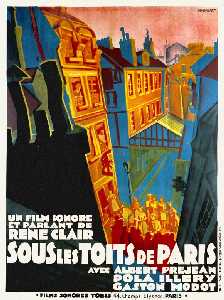
Under the Roofs of Paris is a 1930 French film directed by René Clair. The film was probably the earliest French example of a filmed musical-comedy, although its often dark tone differentiates it from other instances of the genre. This was an early example of sound film in France, along with Prix de beauté and L'Âge d'or. However, Under the Roofs of Paris was the first French production of the sound film era to achieve great international success.

La Géode is a mirror-finished geodesic dome that holds an Omnimax theatre in Parc de la Villette at the Cité des Sciences et de l'Industrie in the 19th arrondissement of Paris, France.

Le Grand Rex is a cinema and concert venue in Paris, France. It is noted for its sumptuous decoration and its outsized main auditorium, which is the largest cinema theatre in Europe.
Louis Fuzelier was a French playwright.

A multiplex is a movie theater complex with multiple screens within a single complex. They are usually housed in a specially designed building. Sometimes, an existing venue undergoes a renovation where the existing auditoriums are split into smaller ones, or more auditoriums are added in an extension or expansion of the building. The largest of these complexes can sit thousands of people and are sometimes referred to as a megaplex.

The Café des 2 Moulins is a café in the Montmartre area of Paris, located at the junction of Rue Lepic and Rue Cauchois. It takes its name from the two nearby historical windmills, Moulin Rouge and Moulin de la Galette. The interior consists of a bar area and multiple small tables.
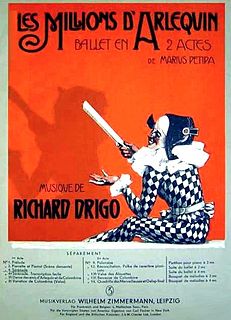
Les Millions d'Arléquin also known under the title Harlequinade is a ballet comique in two acts and two tableaux with libretto and choreography by Marius Petipa and music by Riccardo Drigo. It was first presented at the Hermitage by the Imperial Ballet in St. Petersburg, Russia on 23 February [O.S. 10 February] 1900. The ballet was given a second premiere with the same cast at the Imperial Mariinsky Theatre on 26 February [O.S. 13 February] 1900.
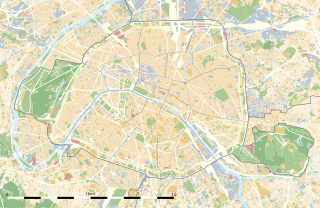
The Palais Berlitz is an office building built in Paris in the 1930s on a block formed by the Boulevard des Italiens, the rue Louis-le-Grand, the Rue de la Michodière and the rue du Hanovre.

The Casino de Paris, located at 16, rue de Clichy, in the 9th arrondissement, is one of the well known music halls of Paris, with a history dating back to the 18th century. Contrary to what the name might suggest, it is a performance venue, not a gambling house. The closest métro/RER stations are Liège, Trinité – d'Estienne d'Orves, and Haussmann – Saint-Lazare.
La Maison Rouge was a private contemporary art Foundation dedicated mainly to showing private art collections, monographic shows of contemporary artists' work. It was located close to the Bastille, in Paris, at 10 Boulevard de la Bastille in the 12th arrondissement of Paris.. La Maison Rouge has been definitely closed in October 2018.
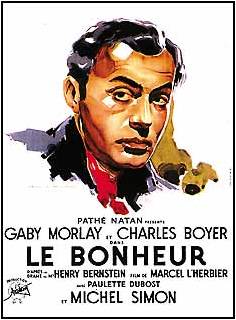
Le Bonheur ("Happiness") is a 1934 French film directed by Marcel L'Herbier. It was adapted from Henri Bernstein's play Le Bonheur, which Bernstein had staged in Paris in March 1933 with Charles Boyer and Michel Simon in leading roles; Boyer and Simon took the same parts in the film.

Pierre-François Godard de Beauchamps, born in 1689 in Paris, where he died on March 12, 1761, was a playwright, theater historian, libertine novelist and French translator. In his youth he was the secretary of François de Neufville, duc de Villeroi, who became governor of the child King Louis XV of France. His most famous works are Arlequin amoureux par enchantement and Les Amans réunis .

Le Divan du Monde is a converted theatre, now functioning as a concert space, located at 75 rue des Martyrs, in the 18th arrondissement, in the Pigalle neighborhood of Paris.

Moscow Cinema, is a cinema hall in the Armenian capital Yerevan, located at the Charles Aznavour Square, adjacent to Abovyan Street.
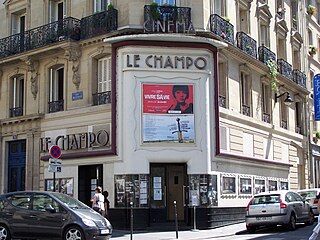
Le Champo, in full Le Champo – Espace Jacques-Tati, is an arthouse cinema in the Latin Quarter of Paris. It is notable for being a favorite haunt of important figures in French cinema history.
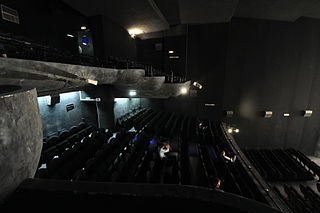
The Max Linder Panorama is a cinema in Paris. It has been described as "one of the most beautiful Parisian movie theatres".

The Cinéma du Panthéon is a movie theater in Paris. It has been in uninterrupted operation for over 100 years.
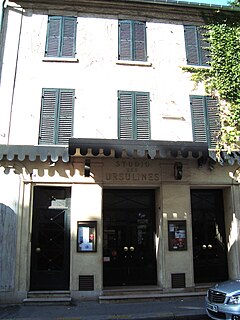
The Studio des Ursulines is a cinema in the 5th arrondissement of Paris, at No.10, Rue des Ursulines. It is one of the oldest cinemas in Paris to have kept its facade and founder's vision: to offer a venue for art and experimental cinema. Gilles Renouard of Paris Cinéphile describes it as 'an astonishing experience' for its nostalgic associations and being able to be within 3 metres of the screen if you sit in the balcony. It has 1 screen.
Coordinates: 48°51′4.01″N2°19′49.76″E / 48.8511139°N 2.3304889°E

A geographic coordinate system is a coordinate system that enables every location on Earth to be specified by a set of numbers, letters or symbols. The coordinates are often chosen such that one of the numbers represents a vertical position and two or three of the numbers represent a horizontal position; alternatively, a geographic position may be expressed in a combined three-dimensional Cartesian vector. A common choice of coordinates is latitude, longitude and elevation. To specify a location on a plane requires a map projection.